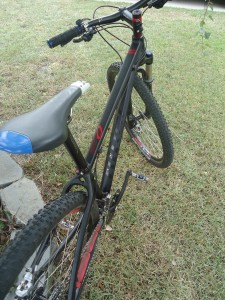Most bikes come as a complete package, leaving less room for customization. I decided to take a new venue to increase my knowledge of bike function by building a bike from scratch or almost from scratch.
Function: When choosing the frame and components for my bike I was looking for something that could be as versatile as possible. Something that could take me 4,084 miles by road, then turn around and tackle the 2,745 mile Tour Divide Mountain Bike Route (a combination of single track, dirt roads, and pavement).
Originally it was a toss up between the Air 9 frame and it’s more economical brother the Niner EMD. After much research I decided on the Niner Air 9 frame. A beautiful, light weight, alloy, race, cross-country 29er hard tail mountain bike. I was able to find the Air 9 frame on sale for: $549.00 versus the normal $849.00 price tag.
Components: When building or buying a bike the type of components you use will make a huge difference. Higher quality components will make shifting effortless and improve function of the bike creating a more enjoyable ride quality. This means more time spent on the bike having fun and a worthwhile investment.
I was able to strip my parts off a new Motobecane 29er mountain bike and my old Cannondale 26″ Hardtail- which helped me do a great build at a decreased price. As well as keep things simple for my first build.
Before diving into buying the components or the bike I was able to check out compatibility of parts with Niner’s tech info from their website. This gives important information on the frame’s compatibility with specific parts (see things to think about) saving some hassle and heart ache down the road. I guess it is not very becoming to sleep with your mountain bike frame until the rest of your parts arrive.
Things to think about:
1. This may seem obvious but ensure you get a frame that is sized for you. If possible test ride different sizes of bikes so you can make sure you get the best possible fit.
2. What travel on the fork is recommended for the frame? Typically 80 to 100 mm on most cross country frames.
3. What is the size of your head tube? Is it 1.5 inches, 1 1/8 inches, or 1 1/8 tapered. This will help you choose the appropriate fork or adapter for your fork to work with your chosen frame.
4. Is the frame compatible with your proposed chain rings? With the Niner Air 9 in particular Shimano XTR 2x chain rings are not recommended as they can be in a position where the large chain ring could potentially contact the bike’s frame.
5. What width of tires will fit on the bike’s frame?
6. What type of bottom bracket do you have?
7. What seat post and seat collar size do you need?
8. What length of seat post does the manufacturer recommend?
9. What diameter is your stem and handlebars? Typically these will be 31.8 but it is always good to double check. When gauging the length of your handle bars keep them longer at first, you can always cut them down later.
10. What type of chain ring set up do you prefer? For example the traditional 3 X 10, 2 x 10, single speed, etc.
11. Ensure that all your parts are made for the wheel size of your mountain bike. In the past 26 was the standard, now the 29er wheel is a huge player on the market, and this year many companies are introducing the 650B or 27.5 wheel size.
Tools: A basic bike tool kit will cover most of the needs for a bike build. The tool kit should at least have: a good hex set (including the most widely used 4, 5, and 6), a Phillips screwdriver, a pedal wrench, tire levers, and a chain break tool. A true work stand will be invaluable during this process. You will need some specialty tools as well including a bottom bracket press (depending on bottom bracket type), a crown race puller (depending on steer tube type), and a torque wrench. While the torque wrench is not an absolute (it is a must have for carbon components) it gives you the piece of mind that everything has been tightened down to the specs listed by the manufacturer. This will help you feel more confident on the bike as well as help combat stripping out screws and bolts in the process of the build.
I can’t say that I have built the perfect machine but I believe it will be pretty darn close to fitting my changing needs with slight alterations. My initial impression is that as long as I choose great lines and commit the bike performs excellent on the trail. Being on the shorter side I enjoy the 29er geometry that Niner offers for shorter riders.
The next couple challenges for my long adventure include creating a custom, bomb proof wheel set and a bike packing system that will stand up to the abuse of a multi-purpose cycling endeavor.
The final build of the bike is included below:
Specs on my Niner Built to Date:
Frame: Niner Air 9 2013- Anodized Licorice
Fork: Rockshock Reba RL 29 with Remote Lock Out, 100 mm of travel
Front Derailleur: Shimano DynaSys XTR, 2x/3x
Rear Derailleur: Shimano DynaSys XTR, 10 Speed
Shifters: Shimnao Dynasys XTR, 2 x 10
Brakes: Avid Elixir 7 Hydraulic Disc
Cassette: Shimano SLX
Crank Set: FSA Afterburner Hollow Forged Aluminum Arms
Wheels: WTB 29”
Tires: Schwable Racing Ralph 29 x 2.25 Performance Line
Pedals: Crankbrothers Eggbeaters
Handlebars: Easton Carbon
Stem: Ritchey Comp Aluminum 31.8
Wheel Set: WTB Stock 29”
Seat post: Thomson Elite
Niner Bikes specializes in 29er bikes for all styles and sizes of riders. More information can be found at ninerbikes.com
